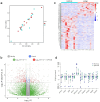Transcriptomic Analysis Reveals Intrinsic Abnormalities in Endometrial Polyps
- PMID: 38473810
- PMCID: PMC10932376
- DOI: 10.3390/ijms25052557
Transcriptomic Analysis Reveals Intrinsic Abnormalities in Endometrial Polyps
Abstract
Endometrial polyps (EPs) are benign overgrowths of the endometrial tissue lining the uterus, often causing abnormal bleeding or infertility. This study analyzed gene expression differences between EPs and adjacent endometrial tissue to elucidate intrinsic abnormalities promoting pathological overgrowth. RNA sequencing of 12 pairs of EPs and the surrounding endometrial tissue from infertile women revealed 322 differentially expressed genes. Protein-protein interaction network analysis revealed significant alterations in specific signaling pathways, notably Wnt signaling and vascular smooth muscle regulation, suggesting these pathways play critical roles in the pathophysiology of EPs. Wnt-related genes DKK1 and DKKL1 were upregulated, while GPC3, GREM1, RSPO3, SFRP5, and WNT10B were downregulated. Relevant genes for vascular smooth muscle contraction were nearly all downregulated in EPs, including ACTA2, ACTG2, KCNMB1, KCNMB2, MYL9, PPP1R12B, and TAGLN. Overall, the results indicate fundamental gene expression changes promote EP formation through unrestrained growth signaling and vascular defects. The intrinsic signaling abnormalities likely contribute to clinical symptoms of abnormal uterine bleeding and infertility common in EP patients. This analysis provides molecular insights into abnormal endometrial overgrowth to guide improved diagnostic and therapeutic approaches for this troublesome women's health condition. Confirmation of expanded cohorts and further investigations into implicated regulatory relationships are warranted.
Keywords: Wnt signaling pathway; endometrial polyps; female infertility; gene expression; vascular smooth muscle.
Conflict of interest statement
The authors declare no conflicts of interest. The funders had no role in the design of the study, in the collection, analyses, or interpretation of data, in the writing of the manuscript, or in the decision to publish the results.
Figures




Similar articles
-
Are There Any Predictors of Endometrial Premalignancy/Malignancy within Endometrial Polyps in Infertile Patients?Gynecol Obstet Invest. 2019;84(5):512-518. doi: 10.1159/000501682. Epub 2019 Jul 16. Gynecol Obstet Invest. 2019. PMID: 31311015
-
Cellular immune environment in endometrial polyps.Fertil Steril. 2013 Nov;100(5):1364-72. doi: 10.1016/j.fertnstert.2013.06.050. Epub 2013 Aug 6. Fertil Steril. 2013. PMID: 23931965
-
Chronic Endometritis, a Common Disease Hidden Behind Endometrial Polyps in Premenopausal Women: First Evidence From a Case-Control Study.J Minim Invasive Gynecol. 2019 Nov-Dec;26(7):1346-1350. doi: 10.1016/j.jmig.2019.01.012. Epub 2019 Jan 29. J Minim Invasive Gynecol. 2019. PMID: 30708117
-
Association between Endometrial Polyps and Chronic Endometritis: Is It Time for a Paradigm Shift in the Pathophysiology of Endometrial Polyps in Pre-Menopausal Women? Results of a Systematic Review and Meta-Analysis.Diagnostics (Basel). 2021 Nov 24;11(12):2182. doi: 10.3390/diagnostics11122182. Diagnostics (Basel). 2021. PMID: 34943419 Free PMC article. Review.
-
Adenomyosis pathogenesis: insights from next-generation sequencing.Hum Reprod Update. 2021 Oct 18;27(6):1086-1097. doi: 10.1093/humupd/dmab017. Hum Reprod Update. 2021. PMID: 34131719 Free PMC article. Review.
Cited by
-
Dydrogesterone for preventing endometrial polyp recurrence after transcervical resection of polyps: protocol for a multicentre randomised controlled trial in China.BMJ Open. 2025 May 6;15(5):e096896. doi: 10.1136/bmjopen-2024-096896. BMJ Open. 2025. PMID: 40335141 Free PMC article.
-
Stanniocalcin Protein Expression in Female Reproductive Organs: Literature Review and Public Cancer Database Analysis.Endocrinology. 2024 Aug 27;165(10):bqae110. doi: 10.1210/endocr/bqae110. Endocrinology. 2024. PMID: 39186548 Free PMC article. Review.
References
-
- Silberstein T., Saphier O., Voorhis B., Plosker S. Endometrial Polyps in Reproductive-Age Fertile and Infertile Women. Isr. Med. Assoc. J. 2006;8:192–195. - PubMed
-
- Check J.H., Bostick-Smith C.A., Choe J.K., Amui J., Brasile D. Matched Controlled Study to Evaluate the Effect of Endometrial Polyps on Pregnancy and Implantation Rates Following In Vitro Fertilization-Embryo Transfer (IVF-ET) Clin. Exp. Obstet. Gynecol. 2011;38:206–208. - PubMed
MeSH terms
Substances
Grants and funding
LinkOut - more resources
Full Text Sources
Medical
Research Materials
Miscellaneous

